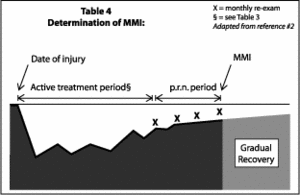Back pain? Blame the psoas. Seems as if everybody wants to dive headfirst into their psoas at the first sign of trouble with the lumbopelvic-hip region. Perhaps no other muscle is blamed more for causing problems than the psoas. Yes, it is an important stabilizer of the lumbar spine, but it shouldn't be the only one on which you focus. There is another big player on the scene: the iliacus.
MVAs and MMI: How Much Is Enough?
For many of us, the issue of maximum medical improvement (MMI) is a true conundrum. This is particularly so in motor vehicle accidents (MVAs) where our patients have often been injured by a negligent driver. In the interest of fairness it would seem most reasonable to allow for indefinite treatment of an injured victim if necessary. In the real world, however, practicality dictates that at some point we make a declaration of MMI. This allows any legal remedy to come to a conclusion and all debts to be (hopefully) paid. Any awards bestowed upon an injured party should take into account the need for future medical or chiropractic care. Patients can also be treated under general health insurance policies in many cases.
Some have suggested using the term "maximum chiropractic improvement" instead of "maximum medical improvement." The difference seems nebulous to me since it presumes that patients treated by chiropractors and medical doctors improve to different degrees, and that has yet to be established (although research is currently under way). In certain settings, a certain amount of ambiguity is allowed anyway. I am a state-appointed independent medical examiner, for example.
I believe the best approach to arriving at MMI is the following: First, grade the severity of the patient's trauma using the severity scale of the SRISD classification of cervical acceleration/deceleration (CAD) trauma,1 Table 1. Next, use the potentially complicating factors in Table 2 as a guide to modify the figures in Table 3 to arrive at a reasonable treatment frequency and duration. For example, in a patient categorized as Grade III with one or two moderate complicating factors, the treatment duration will average about 56 weeks (shorter with no complicating factors and longer with more complicating factors or more severe complications).
Finally, refer to Table 4 to determine MMI. Beyond the active treatment period as suggested by Table 2, after three consecutive monthly re-exams with no further significant objective improvement (range of motion, trigger points, muscle strength, gait, antalgia, orthopedic/neurologic/radiographic signs), you should consider the patient MMI. Gradual further subjective improvement is variable.
References
- Croft AC: Whiplash: the Master's Program. Module I, Whiplash, an Overview. Coronado, Spine Research Institute of San Diego, p 73, 1992.
- Croft AC: Whiplash: the Master's Program. Module III, Treatment and an Introduction to TMJ. Coronado, Spine Research.
Table I
Grades of severity of CAD injury:
Grade I minimal, no limitation of motion, no ligamentous injury, no neurological findings
Grade II slight, limitation of motion, no ligamentous injury, no neurological findings
Grade III moderate, limitation of motion, some ligamentous injury, neurological findings present
Grade IV moderate to severe, limitation of motion, ligamentous instability, neurological findings present, fracture or disc derangement
Grade V severe, requires surgical management/stabilization
Adapted from reference #1
Table 2
Common factors potentially complicating CAD trauma management:
- Advanced age
- Metabolic disorders
- Congenital anomalies of the spine
- Developmental anomalies of the spine
- Degenerative disc disease
- Disc protrusion (HNP)
- Spondylosis
- Facet arthrosis
- Rheumatoid arthritis or other arthritides affecting the spine
- Ankylosing spondylitis or other spondylarthropathy
- Scoliosis
- Prior cervical spinal surgery
- Prior lumbar spinal surgery
- Prior vertebral fracture
- Osteoporosis
- Paget's disease or other disease of bone
- Spinal stenosis or foraminal stenosis
- Paraplegia or quadriplegia
- Prior spinal injury
Especially laminectomy and discectomy without fusion. Adapted from reference 2.
Table 3 | |||||||
Frequency and duration of care in CAD trauma: | |||||||
| Daily | 3x/w | 2x/w | 1x/w | 1x/mos. | TD | TN | |
| Grade I | 1w | 1-2w | 2-3w | <4w | = | <9w | <17 |
| Grade II | 1w | <4w | <4w | <4w | <4 mos. | <25w | <29w |
| Grade III | 1-2w | <10w | <10w | <10w | <6 mos. | <56w | <76w |
| Grade IV | 2-3w | <16w | <12w | <20w | * | * | * |
| Grade V | Surgical stabilization necessary -- chiropractic care is postsurgical | ||||||
| TD = treatment duration. | = Possible follow-up at one month | ||||||
| TN = treatment total number. | * May require permanent monthly or p.r.n. treatment | ||||||
Adapted from reference #2 | |||||||

Arthur C. Croft, D.C., M.S., DABCO
Coronado, California
Editor's Note:
You can get more of Dr. Croft's helpful and educational insights from the video (with Dr. Stephen M. Foreman) "Advances in Personal Injury Practice," #V-435 on the Preferred Reading and Viewing list.



